2019年中考英语二轮专题复习课件:英语简单句基本结构课件20张PPT
文档属性
| 名称 | 2019年中考英语二轮专题复习课件:英语简单句基本结构课件20张PPT | 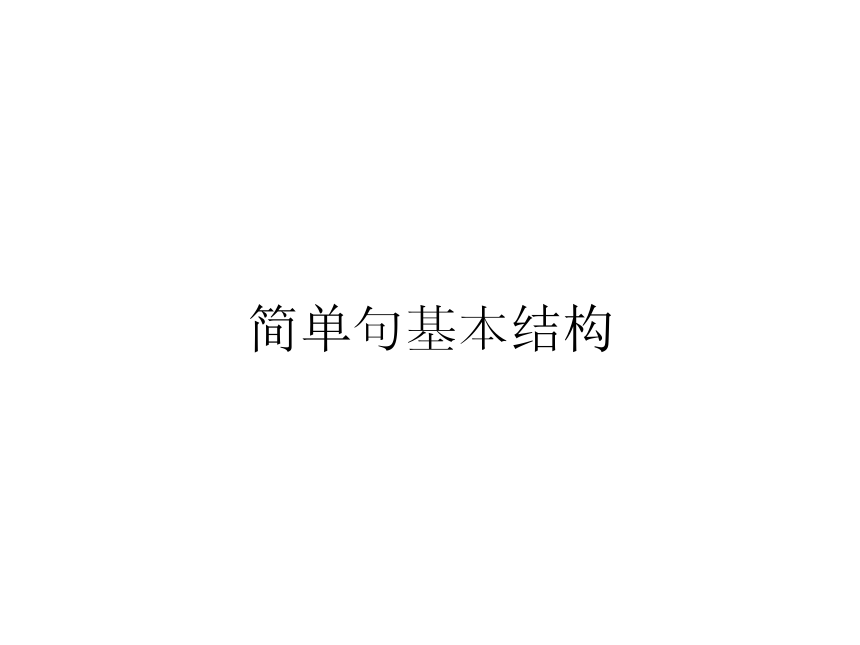 | |
| 格式 | zip | ||
| 文件大小 | 619.8KB | ||
| 资源类型 | 教案 | ||
| 版本资源 | 通用版 | ||
| 科目 | 英语 | ||
| 更新时间 | 2019-06-01 15:06:57 | ||
图片预览

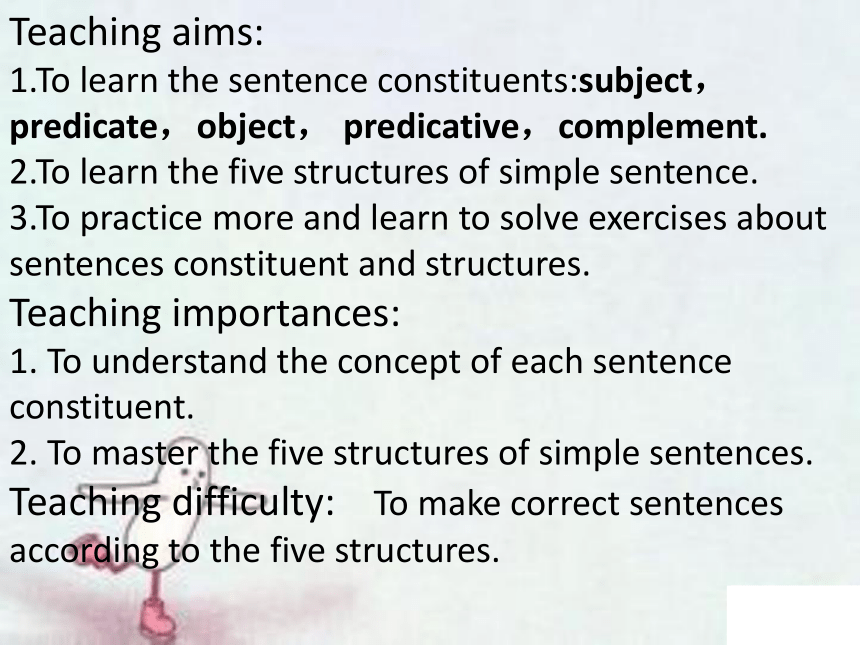
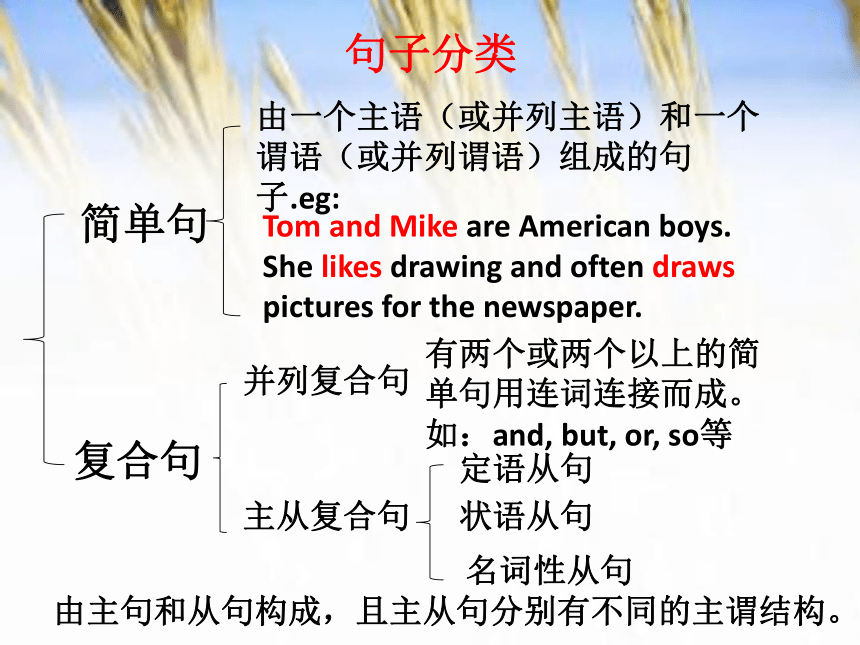
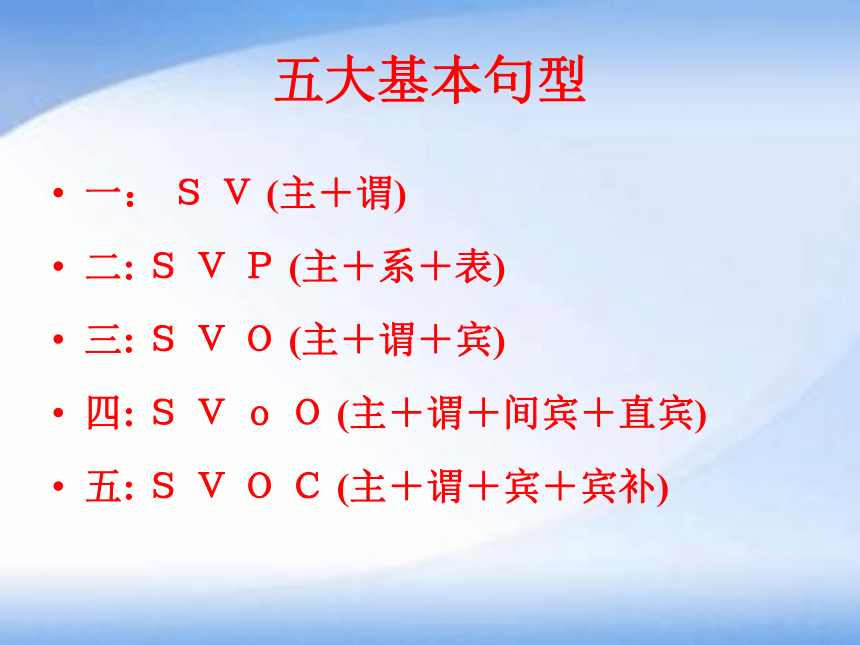
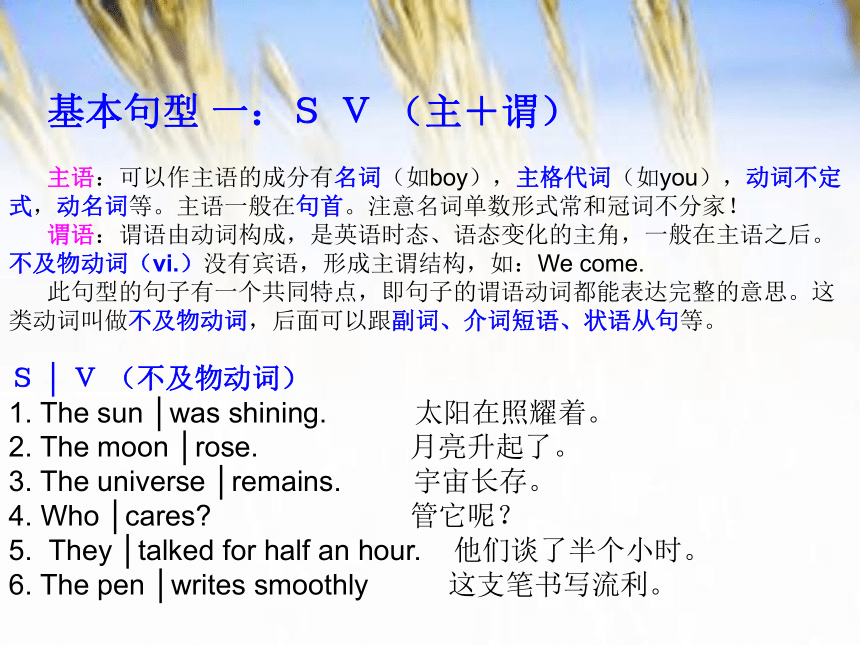
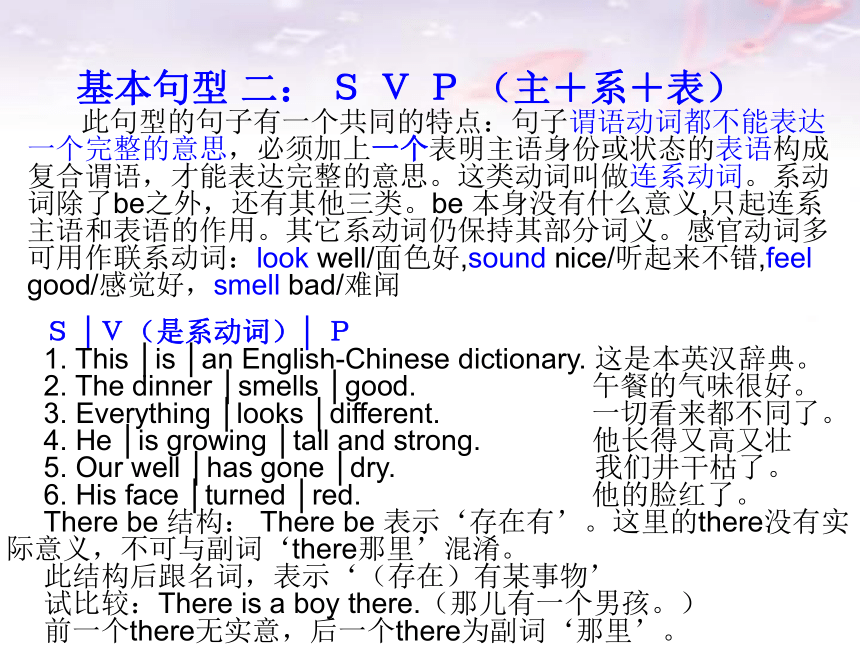
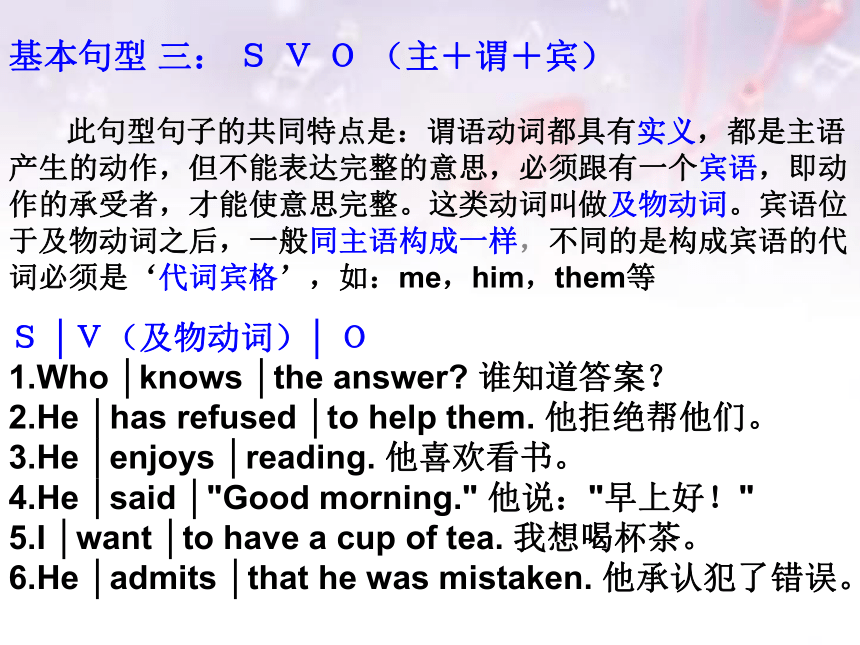
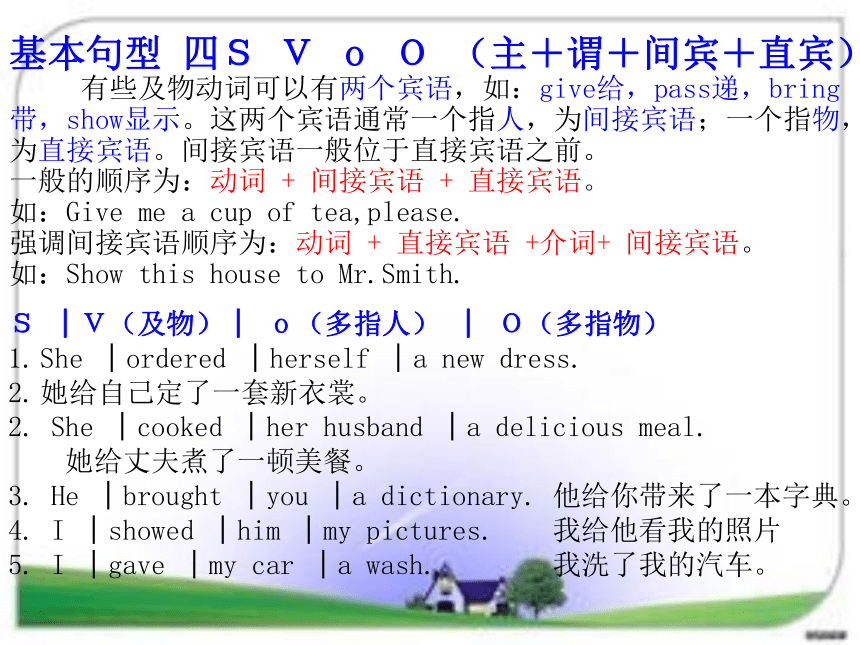

文档简介
简单句基本结构
Teaching aims:
1.To learn the sentence constituents:subject,predicate,object, predicative,complement.
2.To learn the five structures of simple sentence.
3.To practice more and learn to solve exercises about sentences constituent and structures.
Teaching importances:
1. To understand the concept of each sentence constituent.
2. To master the five structures of simple sentences.
Teaching difficulty: To make correct sentences according to the five structures.
句子分类
简单句
复合句
并列复合句
主从复合句
有两个或两个以上的简单句用连词连接而成。
如:and, but, or, so等
定语从句
状语从句
名词性从句
由一个主语(或并列主语)和一个谓语(或并列谓语)组成的句子.eg:
Tom and Mike are American boys.
She likes drawing and often draws pictures for the newspaper.
由主句和从句构成,且主从句分别有不同的主谓结构。
五大基本句型
一: S V (主+谓)
二: S V P (主+系+表)
三: S V O (主+谓+宾)
四: S V o O (主+谓+间宾+直宾)
五: S V O C (主+谓+宾+宾补)
基本句型 一:S V (主+谓)
主语:可以作主语的成分有名词(如boy),主格代词(如you),动词不定式,动名词等。主语一般在句首。注意名词单数形式常和冠词不分家!
谓语:谓语由动词构成,是英语时态、语态变化的主角,一般在主语之后。不及物动词(vi.)没有宾语,形成主谓结构,如:We come.
此句型的句子有一个共同特点,即句子的谓语动词都能表达完整的意思。这类动词叫做不及物动词,后面可以跟副词、介词短语、状语从句等。
S │ V (不及物动词)
1. The sun │was shining. 太阳在照耀着。
2. The moon │rose. 月亮升起了。
3. The universe │remains. 宇宙长存。
4. Who │cares? 管它呢?
5. They │talked for half an hour. 他们谈了半个小时。
6. The pen │writes smoothly 这支笔书写流利。
基本句型 二: S V P (主+系+表)
此句型的句子有一个共同的特点:句子谓语动词都不能表达一个完整的意思,必须加上一个表明主语身份或状态的表语构成复合谓语,才能表达完整的意思。这类动词叫做连系动词。系动词除了be之外,还有其他三类。be 本身没有什么意义,只起连系主语和表语的作用。其它系动词仍保持其部分词义。感官动词多可用作联系动词:look well/面色好,sound nice/听起来不错,feel good/感觉好,smell bad/难闻
S │V(是系动词)│ P
1. This │is │an English-Chinese dictionary. 这是本英汉辞典。
2. The dinner │smells │good. 午餐的气味很好。
3. Everything │looks │different. 一切看来都不同了。
4. He │is growing │tall and strong. 他长得又高又壮
5. Our well │has gone │dry. 我们井干枯了。
6. His face │turned │red. 他的脸红了。
There be 结构: There be 表示‘存在有’。这里的there没有实际意义,不可与副词‘there那里’混淆。
此结构后跟名词,表示‘(存在)有某事物’
试比较:There is a boy there.(那儿有一个男孩。)
前一个there无实意,后一个there为副词‘那里’。
基本句型 三: S V O (主+谓+宾)
此句型句子的共同特点是:谓语动词都具有实义,都是主语产生的动作,但不能表达完整的意思,必须跟有一个宾语,即动作的承受者,才能使意思完整。这类动词叫做及物动词。宾语位于及物动词之后,一般同主语构成一样,不同的是构成宾语的代词必须是‘代词宾格’,如:me,him,them等
S │V(及物动词)│ O
1.Who │knows │the answer? 谁知道答案?
2.He │has refused │to help them. 他拒绝帮他们。
3.He │enjoys │reading. 他喜欢看书。
4.He │said │"Good morning." 他说:"早上好!"
5.I │want │to have a cup of tea. 我想喝杯茶。
6.He │admits │that he was mistaken. 他承认犯了错误。
基本句型 四S V o O (主+谓+间宾+直宾)
有些及物动词可以有两个宾语,如:give给,pass递,bring带,show显示。这两个宾语通常一个指人,为间接宾语;一个指物,为直接宾语。间接宾语一般位于直接宾语之前。
一般的顺序为:动词 + 间接宾语 + 直接宾语。
如:Give me a cup of tea,please.
强调间接宾语顺序为:动词 + 直接宾语 +介词+ 间接宾语。
如:Show this house to Mr.Smith.
S │V(及物)│ o(多指人) │ O(多指物)
She │ordered │herself │a new dress.
她给自己定了一套新衣裳。
2. She │cooked │her husband │a delicious meal.
她给丈夫煮了一顿美餐。
3. He │brought │you │a dictionary. 他给你带来了一本字典。
4. I │showed │him │my pictures. 我给他看我的照片
5. I │gave │my car │a wash. 我洗了我的汽车。
基本句型 五:S V O C
(主+谓+宾+宾补)
此句型的特点是: 动词虽然是及物动词, 但是只跟一个
宾语还不能表达完整的意思, 必须加上一个补充成分
来补足宾语, 才能使意思完整。
宾语补足语: 位于宾语之后对宾语作出说明的成分。
宾语与其补足语有逻辑上的主谓关系,它们一起构成
复合宾语。可以用作宾语补足语的有名词, 形容词,
不定式,动名词, 分词, 介词短语等。
基本句型 五: S V O C (主+谓+宾+宾补)
名词/代词宾格 + 名词
The war made him a soldier. 战争使他成为一名战士.
名词/代词宾格 + 形容词
New methods make the job easy. 新方法使这项工作变得轻松.
名词/代词宾格 + 介词短语
I often find him at work. 我经常发现他在工作.
名词/代词宾格 + 动词不定式
The teacher ask the students to close the windows.
老师让学生们关上窗户.
名词/代词宾格 + 分词
I saw a cat running across the road.我看见一只猫跑过了马路.
a. S V b. S V P c. S V O
d. S V o O e. S V O C
1. Pleas tell us a story. _______
2. She smiled. ______
3. His job is to train swimmers. _____
4. He noticed a man enter the room. _____
5. Please look at the picture. _____
d
a
b
e
c
Exercises I
Exercises 2: 分析句子结构
You are a student.
He felt happy today.
What you said made me happy.
Could you give me some advice on how to learn English well?
After he finished his homework, he went away.
He likes pop music.
Exercises 3:
(一) 挑出下列句中的宾语
1. My brother hasn't done his homework.
2. People all over the world speak English.
3. How many new words did you learn last class?
4.Some of the students in the school want
to go swimming, how about you?
5. Go across the bridge and you will find the museum on the left.
(二) 划出句中的直接宾语和间接宾语
① Please tell us a story.
② My father bought a new bike for me last week.
③ Mr Li is going to teach us history next term.
④ Here is a pen . Give it to Tom.
⑤ Did he leave any message for me?
(三) 挑出下列句中的表语
1. The old man was feeling very tired.
2. Why is he worried about Jim?
3.The leaves have turned yellow.
4.Soon they all became interested in the subject.
5.She was the first to learn about it.
(四) 挑出下列句中的宾语补足语
① She found it difficult to do the work.
②He asked her to take the boy out of school.
③She likes the children to read newspapers and books in the reading-room.
④ They call me Lily sometimes.
⑤ I saw Mr Wang get on the bus.
Exercises 4:
1、 Sorry, we've kept you___ for a long time.
A. waited B. sing C. stand D. waiting
2 、The teacher told us ____ late again.
A. aren't be B. don't be C. not to be D. not be
3 、We find the room very___.
A. warm B. warmly C. terribly D. hardly
4、Two balls are___.
A. under the desk B. in the wall C. to here D. at desks
5、 I want___ a teacher when I grow up .
A. to be B. to C. be D. being
6、 -Would you like to go on a picnic with me today?
-I don't think so. To be honest, I really don't feel like___on a
picnic.
A. going B. to go C. go D. went
Exercises 5: Make sentences
这本有用的字典是妈妈去年给我的。
他对音乐感兴趣。
当冬天来临时,白天变的越来越短。
上周我爸爸给我买了一辆新自行车。
你刚才看到李明正在操场打篮球吗?
The useful dictionary was given by my mother last year.
He is interested in music.
The days get shorter and shorter when winter comes.
My father bought a new bike for me last week.
Did you see Li Ming playing football on the playground just now?
Conclusion:
1. We have learnt the basic sentence
constituents.
2. We have understood five simple sentence structures.
Homework:
1.Do the exercises about the simple sentence structures in the Hexin Tuopo.
2.Preview the contences of next lesson.
Thank you!
Teaching aims:
1.To learn the sentence constituents:subject,predicate,object, predicative,complement.
2.To learn the five structures of simple sentence.
3.To practice more and learn to solve exercises about sentences constituent and structures.
Teaching importances:
1. To understand the concept of each sentence constituent.
2. To master the five structures of simple sentences.
Teaching difficulty: To make correct sentences according to the five structures.
句子分类
简单句
复合句
并列复合句
主从复合句
有两个或两个以上的简单句用连词连接而成。
如:and, but, or, so等
定语从句
状语从句
名词性从句
由一个主语(或并列主语)和一个谓语(或并列谓语)组成的句子.eg:
Tom and Mike are American boys.
She likes drawing and often draws pictures for the newspaper.
由主句和从句构成,且主从句分别有不同的主谓结构。
五大基本句型
一: S V (主+谓)
二: S V P (主+系+表)
三: S V O (主+谓+宾)
四: S V o O (主+谓+间宾+直宾)
五: S V O C (主+谓+宾+宾补)
基本句型 一:S V (主+谓)
主语:可以作主语的成分有名词(如boy),主格代词(如you),动词不定式,动名词等。主语一般在句首。注意名词单数形式常和冠词不分家!
谓语:谓语由动词构成,是英语时态、语态变化的主角,一般在主语之后。不及物动词(vi.)没有宾语,形成主谓结构,如:We come.
此句型的句子有一个共同特点,即句子的谓语动词都能表达完整的意思。这类动词叫做不及物动词,后面可以跟副词、介词短语、状语从句等。
S │ V (不及物动词)
1. The sun │was shining. 太阳在照耀着。
2. The moon │rose. 月亮升起了。
3. The universe │remains. 宇宙长存。
4. Who │cares? 管它呢?
5. They │talked for half an hour. 他们谈了半个小时。
6. The pen │writes smoothly 这支笔书写流利。
基本句型 二: S V P (主+系+表)
此句型的句子有一个共同的特点:句子谓语动词都不能表达一个完整的意思,必须加上一个表明主语身份或状态的表语构成复合谓语,才能表达完整的意思。这类动词叫做连系动词。系动词除了be之外,还有其他三类。be 本身没有什么意义,只起连系主语和表语的作用。其它系动词仍保持其部分词义。感官动词多可用作联系动词:look well/面色好,sound nice/听起来不错,feel good/感觉好,smell bad/难闻
S │V(是系动词)│ P
1. This │is │an English-Chinese dictionary. 这是本英汉辞典。
2. The dinner │smells │good. 午餐的气味很好。
3. Everything │looks │different. 一切看来都不同了。
4. He │is growing │tall and strong. 他长得又高又壮
5. Our well │has gone │dry. 我们井干枯了。
6. His face │turned │red. 他的脸红了。
There be 结构: There be 表示‘存在有’。这里的there没有实际意义,不可与副词‘there那里’混淆。
此结构后跟名词,表示‘(存在)有某事物’
试比较:There is a boy there.(那儿有一个男孩。)
前一个there无实意,后一个there为副词‘那里’。
基本句型 三: S V O (主+谓+宾)
此句型句子的共同特点是:谓语动词都具有实义,都是主语产生的动作,但不能表达完整的意思,必须跟有一个宾语,即动作的承受者,才能使意思完整。这类动词叫做及物动词。宾语位于及物动词之后,一般同主语构成一样,不同的是构成宾语的代词必须是‘代词宾格’,如:me,him,them等
S │V(及物动词)│ O
1.Who │knows │the answer? 谁知道答案?
2.He │has refused │to help them. 他拒绝帮他们。
3.He │enjoys │reading. 他喜欢看书。
4.He │said │"Good morning." 他说:"早上好!"
5.I │want │to have a cup of tea. 我想喝杯茶。
6.He │admits │that he was mistaken. 他承认犯了错误。
基本句型 四S V o O (主+谓+间宾+直宾)
有些及物动词可以有两个宾语,如:give给,pass递,bring带,show显示。这两个宾语通常一个指人,为间接宾语;一个指物,为直接宾语。间接宾语一般位于直接宾语之前。
一般的顺序为:动词 + 间接宾语 + 直接宾语。
如:Give me a cup of tea,please.
强调间接宾语顺序为:动词 + 直接宾语 +介词+ 间接宾语。
如:Show this house to Mr.Smith.
S │V(及物)│ o(多指人) │ O(多指物)
She │ordered │herself │a new dress.
她给自己定了一套新衣裳。
2. She │cooked │her husband │a delicious meal.
她给丈夫煮了一顿美餐。
3. He │brought │you │a dictionary. 他给你带来了一本字典。
4. I │showed │him │my pictures. 我给他看我的照片
5. I │gave │my car │a wash. 我洗了我的汽车。
基本句型 五:S V O C
(主+谓+宾+宾补)
此句型的特点是: 动词虽然是及物动词, 但是只跟一个
宾语还不能表达完整的意思, 必须加上一个补充成分
来补足宾语, 才能使意思完整。
宾语补足语: 位于宾语之后对宾语作出说明的成分。
宾语与其补足语有逻辑上的主谓关系,它们一起构成
复合宾语。可以用作宾语补足语的有名词, 形容词,
不定式,动名词, 分词, 介词短语等。
基本句型 五: S V O C (主+谓+宾+宾补)
名词/代词宾格 + 名词
The war made him a soldier. 战争使他成为一名战士.
名词/代词宾格 + 形容词
New methods make the job easy. 新方法使这项工作变得轻松.
名词/代词宾格 + 介词短语
I often find him at work. 我经常发现他在工作.
名词/代词宾格 + 动词不定式
The teacher ask the students to close the windows.
老师让学生们关上窗户.
名词/代词宾格 + 分词
I saw a cat running across the road.我看见一只猫跑过了马路.
a. S V b. S V P c. S V O
d. S V o O e. S V O C
1. Pleas tell us a story. _______
2. She smiled. ______
3. His job is to train swimmers. _____
4. He noticed a man enter the room. _____
5. Please look at the picture. _____
d
a
b
e
c
Exercises I
Exercises 2: 分析句子结构
You are a student.
He felt happy today.
What you said made me happy.
Could you give me some advice on how to learn English well?
After he finished his homework, he went away.
He likes pop music.
Exercises 3:
(一) 挑出下列句中的宾语
1. My brother hasn't done his homework.
2. People all over the world speak English.
3. How many new words did you learn last class?
4.Some of the students in the school want
to go swimming, how about you?
5. Go across the bridge and you will find the museum on the left.
(二) 划出句中的直接宾语和间接宾语
① Please tell us a story.
② My father bought a new bike for me last week.
③ Mr Li is going to teach us history next term.
④ Here is a pen . Give it to Tom.
⑤ Did he leave any message for me?
(三) 挑出下列句中的表语
1. The old man was feeling very tired.
2. Why is he worried about Jim?
3.The leaves have turned yellow.
4.Soon they all became interested in the subject.
5.She was the first to learn about it.
(四) 挑出下列句中的宾语补足语
① She found it difficult to do the work.
②He asked her to take the boy out of school.
③She likes the children to read newspapers and books in the reading-room.
④ They call me Lily sometimes.
⑤ I saw Mr Wang get on the bus.
Exercises 4:
1、 Sorry, we've kept you___ for a long time.
A. waited B. sing C. stand D. waiting
2 、The teacher told us ____ late again.
A. aren't be B. don't be C. not to be D. not be
3 、We find the room very___.
A. warm B. warmly C. terribly D. hardly
4、Two balls are___.
A. under the desk B. in the wall C. to here D. at desks
5、 I want___ a teacher when I grow up .
A. to be B. to C. be D. being
6、 -Would you like to go on a picnic with me today?
-I don't think so. To be honest, I really don't feel like___on a
picnic.
A. going B. to go C. go D. went
Exercises 5: Make sentences
这本有用的字典是妈妈去年给我的。
他对音乐感兴趣。
当冬天来临时,白天变的越来越短。
上周我爸爸给我买了一辆新自行车。
你刚才看到李明正在操场打篮球吗?
The useful dictionary was given by my mother last year.
He is interested in music.
The days get shorter and shorter when winter comes.
My father bought a new bike for me last week.
Did you see Li Ming playing football on the playground just now?
Conclusion:
1. We have learnt the basic sentence
constituents.
2. We have understood five simple sentence structures.
Homework:
1.Do the exercises about the simple sentence structures in the Hexin Tuopo.
2.Preview the contences of next lesson.
Thank you!
同课章节目录
- 词法
- 名词
- 动词和动词短语
- 动词语态
- 动词时态
- 助动词和情态动词
- 非谓语动词
- 冠词
- 代词
- 数词和量词
- 形容词副词及其比较等级
- 介词和介词短语
- 连词和感叹词
- 构词法
- 相似、相近词比较
- 句法
- 陈述句
- 一般疑问句和否定疑问句
- 特殊疑问句及选择疑问句
- 反意疑问句
- 存在句(There be句型)
- 宾语从句
- 定语从句
- 状语从句
- 主谓一致问题
- 简单句
- 并列句
- 复合句
- 主谓一致
- 主、表语从句
- 名词性从句
- 直接引语和间接引语
- 虚拟语气
- 感叹句
- 强调句
- 倒装句
- 祈使句
- 句子的成分
- 句子的分类
- 题型专区
- 单项选择部分
- 易错题
- 完形填空
- 阅读理解
- 词汇练习
- 听说训练
- 句型转换
- 补全对话
- 短文改错
- 翻译
- 书面表达
- 任务型阅读
- 语法填空
- 其他资料
